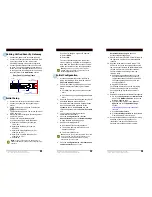
©
National Instruments Corporation
3
NI WSN-9791 User Guide and Specifications
Safety Guidelines
Operate the NI WSN-9791 only as described in this user guide.
Hot Surface
This icon denotes that the component may be hot. Touching this component may result
in bodily injury.
NI WSN Safety Information
The following section contains important safety information that you
must
follow when installing and
using NI WSN products.
Caution
Do
not
substitute parts or modify the NI WSN product. Use the product only with the
devices, accessories, and cables specified in the installation instructions.
Caution
Do
not
operate a NI WSN products in an explosive atmosphere or where there may be
flammable gases or fumes. If you need to operate NI WSN products in such an environment, the
NI WSN products
must
be in a suitably rated enclosure.
Caution
If you need to clean a NI WSN product, use a dry towel. The product
must
be completely
dry and free from contaminants before you return it to service.
Caution
Operate the product only at or below Pollution Degree 2. Pollution is foreign matter in a
solid, liquid, or gaseous state that can reduce dielectric strength or surface resistivity. The following
is a description of pollution degrees:
•
Pollution Degree 1 means no pollution or only dry, nonconductive pollution occurs. The pollution
has no influence.
•
Pollution Degree 2 means that only nonconductive pollution occurs in most cases. Occasionally,
however, a temporary conductivity caused by condensation must be expected.
•
Pollution Degree 3 means that conductive pollution occurs, or dry, nonconductive pollution occurs
which becomes conductive due to condensation.
Caution
You
must
insulate signal connections for the maximum voltage for which the NI WSN
product is rated. Do
not
exceed the maximum ratings for the product. Do
not
install wiring while
the product is live with electrical signals. Do
not
remove or add connector blocks when power is
connected to the NI WSN system. Avoid contact between your body and the connector block signal
wiring when hot-swapping devices.
Operate NI WSN products at or below the
installation category
1
marked on the hardware label.
Measurement circuits are subjected to
working voltages
2
and transient stresses (overvoltage) from
the circuit to which they are connected during measurement or test. Installation categories establish
standard impulse withstand voltage levels that commonly occur in electrical distribution systems.
The following is a description of installation categories:
•
Installation Category I is for measurements performed on circuits not directly connected to the
electrical distribution system referred to as MAINS
3
voltage. This category is for measurements of
voltages from specially protected secondary circuits. Such voltage measurements include signal
1
Installation categories, also referred to as
measurement categories
, are defined in electrical safety standard IEC 61010-1.
2
Working voltage is the highest rms value of an AC or DC voltage that can occur across any particular insulation.
3
MAINS is defined as a hazardous live electrical supply system that powers equipment. Suitably rated measuring circuits may
be connected to the MAINS for measuring purposes.




































